Sustainable Agricultural Practices and Water Management
VerifiedAdded on 2020/03/16
|5
|2428
|36
AI Summary
This assignment delves into the critical topic of sustainable agriculture, focusing on water management strategies crucial for ensuring global food security. It examines different farming practices, their impact on greenhouse gas emissions, nutrient cycling, and soil health. The text explores water scarcity issues, irrigation techniques, and the role of technology in optimizing agricultural production while minimizing environmental impact. Case studies and research findings are utilized to illustrate successful sustainable agriculture models.
Contribute Materials
Your contribution can guide someone’s learning journey. Share your
documents today.
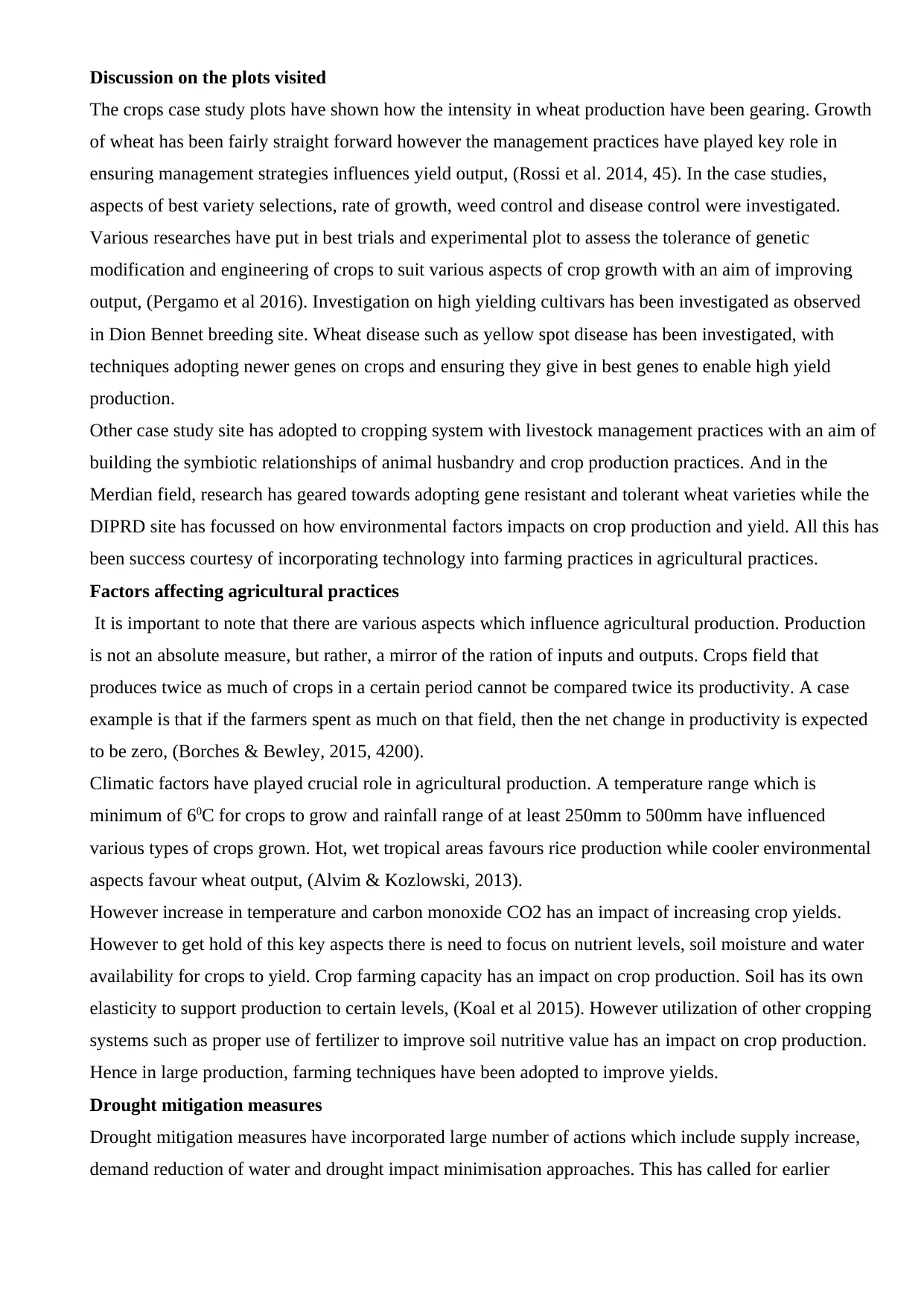
Discussion on the plots visited
The crops case study plots have shown how the intensity in wheat production have been gearing. Growth
of wheat has been fairly straight forward however the management practices have played key role in
ensuring management strategies influences yield output, (Rossi et al. 2014, 45). In the case studies,
aspects of best variety selections, rate of growth, weed control and disease control were investigated.
Various researches have put in best trials and experimental plot to assess the tolerance of genetic
modification and engineering of crops to suit various aspects of crop growth with an aim of improving
output, (Pergamo et al 2016). Investigation on high yielding cultivars has been investigated as observed
in Dion Bennet breeding site. Wheat disease such as yellow spot disease has been investigated, with
techniques adopting newer genes on crops and ensuring they give in best genes to enable high yield
production.
Other case study site has adopted to cropping system with livestock management practices with an aim of
building the symbiotic relationships of animal husbandry and crop production practices. And in the
Merdian field, research has geared towards adopting gene resistant and tolerant wheat varieties while the
DIPRD site has focussed on how environmental factors impacts on crop production and yield. All this has
been success courtesy of incorporating technology into farming practices in agricultural practices.
Factors affecting agricultural practices
It is important to note that there are various aspects which influence agricultural production. Production
is not an absolute measure, but rather, a mirror of the ration of inputs and outputs. Crops field that
produces twice as much of crops in a certain period cannot be compared twice its productivity. A case
example is that if the farmers spent as much on that field, then the net change in productivity is expected
to be zero, (Borches & Bewley, 2015, 4200).
Climatic factors have played crucial role in agricultural production. A temperature range which is
minimum of 60C for crops to grow and rainfall range of at least 250mm to 500mm have influenced
various types of crops grown. Hot, wet tropical areas favours rice production while cooler environmental
aspects favour wheat output, (Alvim & Kozlowski, 2013).
However increase in temperature and carbon monoxide CO2 has an impact of increasing crop yields.
However to get hold of this key aspects there is need to focus on nutrient levels, soil moisture and water
availability for crops to yield. Crop farming capacity has an impact on crop production. Soil has its own
elasticity to support production to certain levels, (Koal et al 2015). However utilization of other cropping
systems such as proper use of fertilizer to improve soil nutritive value has an impact on crop production.
Hence in large production, farming techniques have been adopted to improve yields.
Drought mitigation measures
Drought mitigation measures have incorporated large number of actions which include supply increase,
demand reduction of water and drought impact minimisation approaches. This has called for earlier
The crops case study plots have shown how the intensity in wheat production have been gearing. Growth
of wheat has been fairly straight forward however the management practices have played key role in
ensuring management strategies influences yield output, (Rossi et al. 2014, 45). In the case studies,
aspects of best variety selections, rate of growth, weed control and disease control were investigated.
Various researches have put in best trials and experimental plot to assess the tolerance of genetic
modification and engineering of crops to suit various aspects of crop growth with an aim of improving
output, (Pergamo et al 2016). Investigation on high yielding cultivars has been investigated as observed
in Dion Bennet breeding site. Wheat disease such as yellow spot disease has been investigated, with
techniques adopting newer genes on crops and ensuring they give in best genes to enable high yield
production.
Other case study site has adopted to cropping system with livestock management practices with an aim of
building the symbiotic relationships of animal husbandry and crop production practices. And in the
Merdian field, research has geared towards adopting gene resistant and tolerant wheat varieties while the
DIPRD site has focussed on how environmental factors impacts on crop production and yield. All this has
been success courtesy of incorporating technology into farming practices in agricultural practices.
Factors affecting agricultural practices
It is important to note that there are various aspects which influence agricultural production. Production
is not an absolute measure, but rather, a mirror of the ration of inputs and outputs. Crops field that
produces twice as much of crops in a certain period cannot be compared twice its productivity. A case
example is that if the farmers spent as much on that field, then the net change in productivity is expected
to be zero, (Borches & Bewley, 2015, 4200).
Climatic factors have played crucial role in agricultural production. A temperature range which is
minimum of 60C for crops to grow and rainfall range of at least 250mm to 500mm have influenced
various types of crops grown. Hot, wet tropical areas favours rice production while cooler environmental
aspects favour wheat output, (Alvim & Kozlowski, 2013).
However increase in temperature and carbon monoxide CO2 has an impact of increasing crop yields.
However to get hold of this key aspects there is need to focus on nutrient levels, soil moisture and water
availability for crops to yield. Crop farming capacity has an impact on crop production. Soil has its own
elasticity to support production to certain levels, (Koal et al 2015). However utilization of other cropping
systems such as proper use of fertilizer to improve soil nutritive value has an impact on crop production.
Hence in large production, farming techniques have been adopted to improve yields.
Drought mitigation measures
Drought mitigation measures have incorporated large number of actions which include supply increase,
demand reduction of water and drought impact minimisation approaches. This has called for earlier
Secure Best Marks with AI Grader
Need help grading? Try our AI Grader for instant feedback on your assignments.
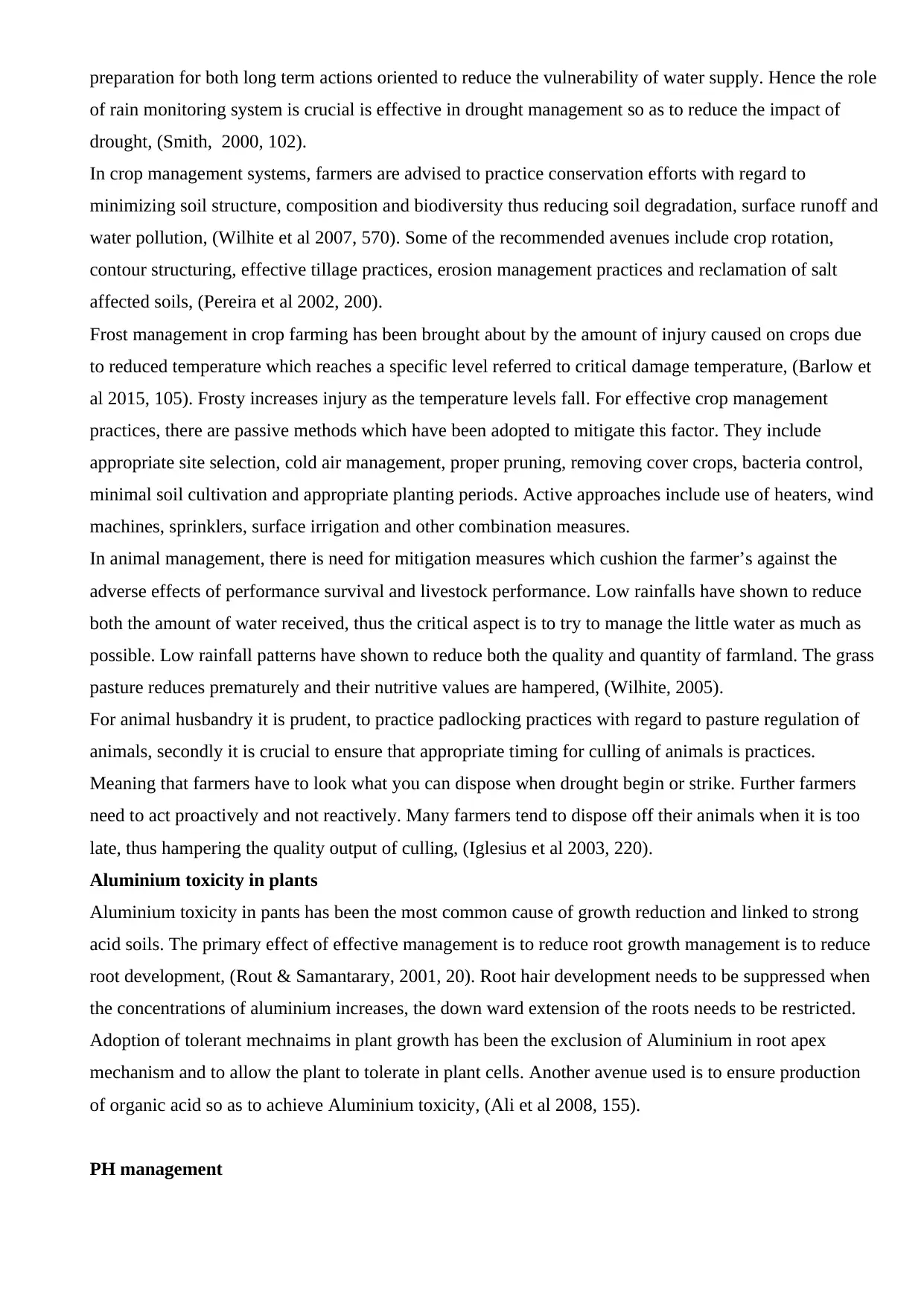
preparation for both long term actions oriented to reduce the vulnerability of water supply. Hence the role
of rain monitoring system is crucial is effective in drought management so as to reduce the impact of
drought, (Smith, 2000, 102).
In crop management systems, farmers are advised to practice conservation efforts with regard to
minimizing soil structure, composition and biodiversity thus reducing soil degradation, surface runoff and
water pollution, (Wilhite et al 2007, 570). Some of the recommended avenues include crop rotation,
contour structuring, effective tillage practices, erosion management practices and reclamation of salt
affected soils, (Pereira et al 2002, 200).
Frost management in crop farming has been brought about by the amount of injury caused on crops due
to reduced temperature which reaches a specific level referred to critical damage temperature, (Barlow et
al 2015, 105). Frosty increases injury as the temperature levels fall. For effective crop management
practices, there are passive methods which have been adopted to mitigate this factor. They include
appropriate site selection, cold air management, proper pruning, removing cover crops, bacteria control,
minimal soil cultivation and appropriate planting periods. Active approaches include use of heaters, wind
machines, sprinklers, surface irrigation and other combination measures.
In animal management, there is need for mitigation measures which cushion the farmer’s against the
adverse effects of performance survival and livestock performance. Low rainfalls have shown to reduce
both the amount of water received, thus the critical aspect is to try to manage the little water as much as
possible. Low rainfall patterns have shown to reduce both the quality and quantity of farmland. The grass
pasture reduces prematurely and their nutritive values are hampered, (Wilhite, 2005).
For animal husbandry it is prudent, to practice padlocking practices with regard to pasture regulation of
animals, secondly it is crucial to ensure that appropriate timing for culling of animals is practices.
Meaning that farmers have to look what you can dispose when drought begin or strike. Further farmers
need to act proactively and not reactively. Many farmers tend to dispose off their animals when it is too
late, thus hampering the quality output of culling, (Iglesius et al 2003, 220).
Aluminium toxicity in plants
Aluminium toxicity in pants has been the most common cause of growth reduction and linked to strong
acid soils. The primary effect of effective management is to reduce root growth management is to reduce
root development, (Rout & Samantarary, 2001, 20). Root hair development needs to be suppressed when
the concentrations of aluminium increases, the down ward extension of the roots needs to be restricted.
Adoption of tolerant mechnaims in plant growth has been the exclusion of Aluminium in root apex
mechanism and to allow the plant to tolerate in plant cells. Another avenue used is to ensure production
of organic acid so as to achieve Aluminium toxicity, (Ali et al 2008, 155).
PH management
of rain monitoring system is crucial is effective in drought management so as to reduce the impact of
drought, (Smith, 2000, 102).
In crop management systems, farmers are advised to practice conservation efforts with regard to
minimizing soil structure, composition and biodiversity thus reducing soil degradation, surface runoff and
water pollution, (Wilhite et al 2007, 570). Some of the recommended avenues include crop rotation,
contour structuring, effective tillage practices, erosion management practices and reclamation of salt
affected soils, (Pereira et al 2002, 200).
Frost management in crop farming has been brought about by the amount of injury caused on crops due
to reduced temperature which reaches a specific level referred to critical damage temperature, (Barlow et
al 2015, 105). Frosty increases injury as the temperature levels fall. For effective crop management
practices, there are passive methods which have been adopted to mitigate this factor. They include
appropriate site selection, cold air management, proper pruning, removing cover crops, bacteria control,
minimal soil cultivation and appropriate planting periods. Active approaches include use of heaters, wind
machines, sprinklers, surface irrigation and other combination measures.
In animal management, there is need for mitigation measures which cushion the farmer’s against the
adverse effects of performance survival and livestock performance. Low rainfalls have shown to reduce
both the amount of water received, thus the critical aspect is to try to manage the little water as much as
possible. Low rainfall patterns have shown to reduce both the quality and quantity of farmland. The grass
pasture reduces prematurely and their nutritive values are hampered, (Wilhite, 2005).
For animal husbandry it is prudent, to practice padlocking practices with regard to pasture regulation of
animals, secondly it is crucial to ensure that appropriate timing for culling of animals is practices.
Meaning that farmers have to look what you can dispose when drought begin or strike. Further farmers
need to act proactively and not reactively. Many farmers tend to dispose off their animals when it is too
late, thus hampering the quality output of culling, (Iglesius et al 2003, 220).
Aluminium toxicity in plants
Aluminium toxicity in pants has been the most common cause of growth reduction and linked to strong
acid soils. The primary effect of effective management is to reduce root growth management is to reduce
root development, (Rout & Samantarary, 2001, 20). Root hair development needs to be suppressed when
the concentrations of aluminium increases, the down ward extension of the roots needs to be restricted.
Adoption of tolerant mechnaims in plant growth has been the exclusion of Aluminium in root apex
mechanism and to allow the plant to tolerate in plant cells. Another avenue used is to ensure production
of organic acid so as to achieve Aluminium toxicity, (Ali et al 2008, 155).
PH management
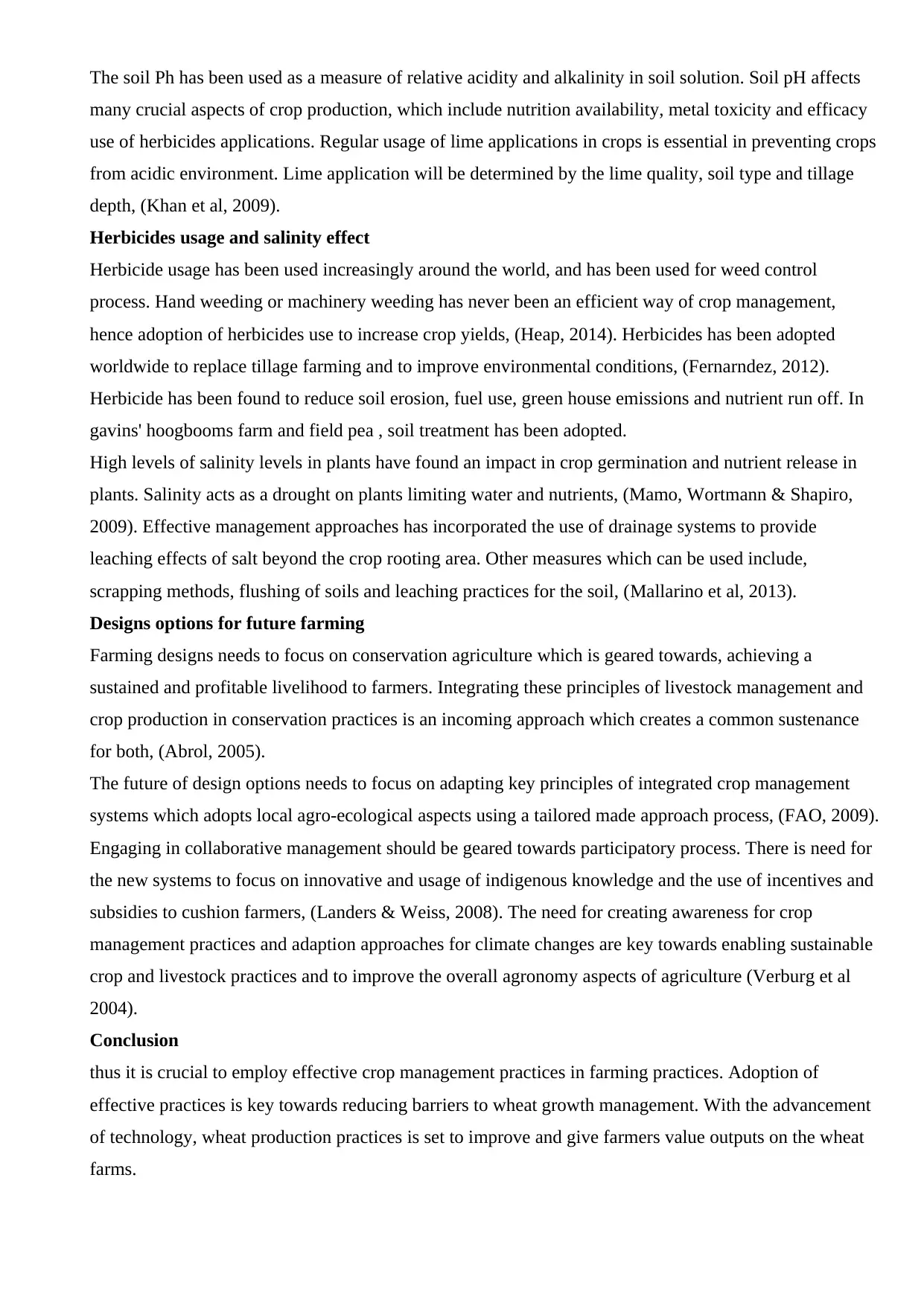
The soil Ph has been used as a measure of relative acidity and alkalinity in soil solution. Soil pH affects
many crucial aspects of crop production, which include nutrition availability, metal toxicity and efficacy
use of herbicides applications. Regular usage of lime applications in crops is essential in preventing crops
from acidic environment. Lime application will be determined by the lime quality, soil type and tillage
depth, (Khan et al, 2009).
Herbicides usage and salinity effect
Herbicide usage has been used increasingly around the world, and has been used for weed control
process. Hand weeding or machinery weeding has never been an efficient way of crop management,
hence adoption of herbicides use to increase crop yields, (Heap, 2014). Herbicides has been adopted
worldwide to replace tillage farming and to improve environmental conditions, (Fernarndez, 2012).
Herbicide has been found to reduce soil erosion, fuel use, green house emissions and nutrient run off. In
gavins' hoogbooms farm and field pea , soil treatment has been adopted.
High levels of salinity levels in plants have found an impact in crop germination and nutrient release in
plants. Salinity acts as a drought on plants limiting water and nutrients, (Mamo, Wortmann & Shapiro,
2009). Effective management approaches has incorporated the use of drainage systems to provide
leaching effects of salt beyond the crop rooting area. Other measures which can be used include,
scrapping methods, flushing of soils and leaching practices for the soil, (Mallarino et al, 2013).
Designs options for future farming
Farming designs needs to focus on conservation agriculture which is geared towards, achieving a
sustained and profitable livelihood to farmers. Integrating these principles of livestock management and
crop production in conservation practices is an incoming approach which creates a common sustenance
for both, (Abrol, 2005).
The future of design options needs to focus on adapting key principles of integrated crop management
systems which adopts local agro-ecological aspects using a tailored made approach process, (FAO, 2009).
Engaging in collaborative management should be geared towards participatory process. There is need for
the new systems to focus on innovative and usage of indigenous knowledge and the use of incentives and
subsidies to cushion farmers, (Landers & Weiss, 2008). The need for creating awareness for crop
management practices and adaption approaches for climate changes are key towards enabling sustainable
crop and livestock practices and to improve the overall agronomy aspects of agriculture (Verburg et al
2004).
Conclusion
thus it is crucial to employ effective crop management practices in farming practices. Adoption of
effective practices is key towards reducing barriers to wheat growth management. With the advancement
of technology, wheat production practices is set to improve and give farmers value outputs on the wheat
farms.
many crucial aspects of crop production, which include nutrition availability, metal toxicity and efficacy
use of herbicides applications. Regular usage of lime applications in crops is essential in preventing crops
from acidic environment. Lime application will be determined by the lime quality, soil type and tillage
depth, (Khan et al, 2009).
Herbicides usage and salinity effect
Herbicide usage has been used increasingly around the world, and has been used for weed control
process. Hand weeding or machinery weeding has never been an efficient way of crop management,
hence adoption of herbicides use to increase crop yields, (Heap, 2014). Herbicides has been adopted
worldwide to replace tillage farming and to improve environmental conditions, (Fernarndez, 2012).
Herbicide has been found to reduce soil erosion, fuel use, green house emissions and nutrient run off. In
gavins' hoogbooms farm and field pea , soil treatment has been adopted.
High levels of salinity levels in plants have found an impact in crop germination and nutrient release in
plants. Salinity acts as a drought on plants limiting water and nutrients, (Mamo, Wortmann & Shapiro,
2009). Effective management approaches has incorporated the use of drainage systems to provide
leaching effects of salt beyond the crop rooting area. Other measures which can be used include,
scrapping methods, flushing of soils and leaching practices for the soil, (Mallarino et al, 2013).
Designs options for future farming
Farming designs needs to focus on conservation agriculture which is geared towards, achieving a
sustained and profitable livelihood to farmers. Integrating these principles of livestock management and
crop production in conservation practices is an incoming approach which creates a common sustenance
for both, (Abrol, 2005).
The future of design options needs to focus on adapting key principles of integrated crop management
systems which adopts local agro-ecological aspects using a tailored made approach process, (FAO, 2009).
Engaging in collaborative management should be geared towards participatory process. There is need for
the new systems to focus on innovative and usage of indigenous knowledge and the use of incentives and
subsidies to cushion farmers, (Landers & Weiss, 2008). The need for creating awareness for crop
management practices and adaption approaches for climate changes are key towards enabling sustainable
crop and livestock practices and to improve the overall agronomy aspects of agriculture (Verburg et al
2004).
Conclusion
thus it is crucial to employ effective crop management practices in farming practices. Adoption of
effective practices is key towards reducing barriers to wheat growth management. With the advancement
of technology, wheat production practices is set to improve and give farmers value outputs on the wheat
farms.
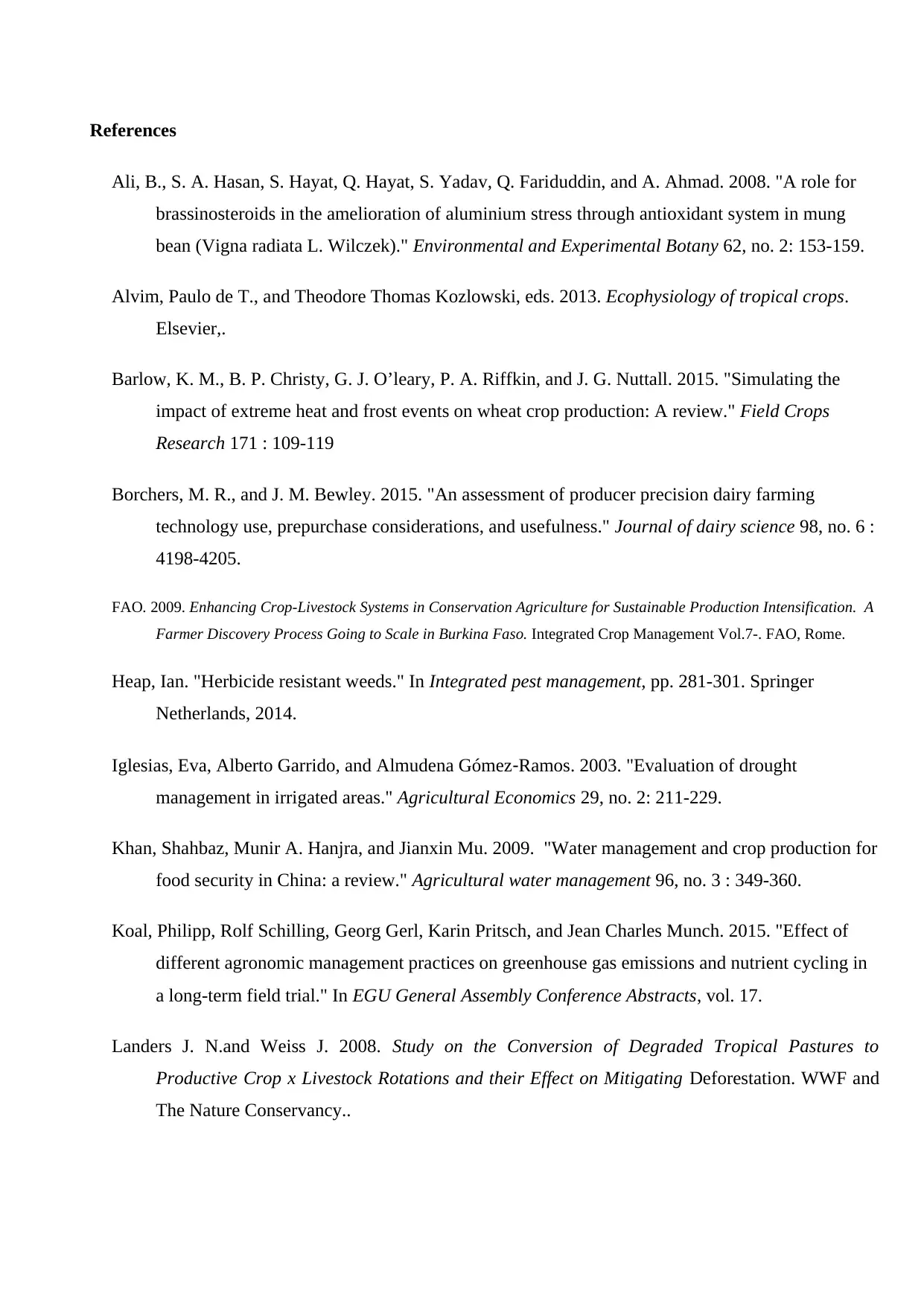
References
Ali, B., S. A. Hasan, S. Hayat, Q. Hayat, S. Yadav, Q. Fariduddin, and A. Ahmad. 2008. "A role for
brassinosteroids in the amelioration of aluminium stress through antioxidant system in mung
bean (Vigna radiata L. Wilczek)." Environmental and Experimental Botany 62, no. 2: 153-159.
Alvim, Paulo de T., and Theodore Thomas Kozlowski, eds. 2013. Ecophysiology of tropical crops.
Elsevier,.
Barlow, K. M., B. P. Christy, G. J. O’leary, P. A. Riffkin, and J. G. Nuttall. 2015. "Simulating the
impact of extreme heat and frost events on wheat crop production: A review." Field Crops
Research 171 : 109-119
Borchers, M. R., and J. M. Bewley. 2015. "An assessment of producer precision dairy farming
technology use, prepurchase considerations, and usefulness." Journal of dairy science 98, no. 6 :
4198-4205.
FAO. 2009. Enhancing Crop-Livestock Systems in Conservation Agriculture for Sustainable Production Intensification. A
Farmer Discovery Process Going to Scale in Burkina Faso. Integrated Crop Management Vol.7-. FAO, Rome.
Heap, Ian. "Herbicide resistant weeds." In Integrated pest management, pp. 281-301. Springer
Netherlands, 2014.
Iglesias, Eva, Alberto Garrido, and Almudena Gómez‐Ramos. 2003. "Evaluation of drought
management in irrigated areas." Agricultural Economics 29, no. 2: 211-229.
Khan, Shahbaz, Munir A. Hanjra, and Jianxin Mu. 2009. "Water management and crop production for
food security in China: a review." Agricultural water management 96, no. 3 : 349-360.
Koal, Philipp, Rolf Schilling, Georg Gerl, Karin Pritsch, and Jean Charles Munch. 2015. "Effect of
different agronomic management practices on greenhouse gas emissions and nutrient cycling in
a long-term field trial." In EGU General Assembly Conference Abstracts, vol. 17.
Landers J. N.and Weiss J. 2008. Study on the Conversion of Degraded Tropical Pastures to
Productive Crop x Livestock Rotations and their Effect on Mitigating Deforestation. WWF and
The Nature Conservancy..
Ali, B., S. A. Hasan, S. Hayat, Q. Hayat, S. Yadav, Q. Fariduddin, and A. Ahmad. 2008. "A role for
brassinosteroids in the amelioration of aluminium stress through antioxidant system in mung
bean (Vigna radiata L. Wilczek)." Environmental and Experimental Botany 62, no. 2: 153-159.
Alvim, Paulo de T., and Theodore Thomas Kozlowski, eds. 2013. Ecophysiology of tropical crops.
Elsevier,.
Barlow, K. M., B. P. Christy, G. J. O’leary, P. A. Riffkin, and J. G. Nuttall. 2015. "Simulating the
impact of extreme heat and frost events on wheat crop production: A review." Field Crops
Research 171 : 109-119
Borchers, M. R., and J. M. Bewley. 2015. "An assessment of producer precision dairy farming
technology use, prepurchase considerations, and usefulness." Journal of dairy science 98, no. 6 :
4198-4205.
FAO. 2009. Enhancing Crop-Livestock Systems in Conservation Agriculture for Sustainable Production Intensification. A
Farmer Discovery Process Going to Scale in Burkina Faso. Integrated Crop Management Vol.7-. FAO, Rome.
Heap, Ian. "Herbicide resistant weeds." In Integrated pest management, pp. 281-301. Springer
Netherlands, 2014.
Iglesias, Eva, Alberto Garrido, and Almudena Gómez‐Ramos. 2003. "Evaluation of drought
management in irrigated areas." Agricultural Economics 29, no. 2: 211-229.
Khan, Shahbaz, Munir A. Hanjra, and Jianxin Mu. 2009. "Water management and crop production for
food security in China: a review." Agricultural water management 96, no. 3 : 349-360.
Koal, Philipp, Rolf Schilling, Georg Gerl, Karin Pritsch, and Jean Charles Munch. 2015. "Effect of
different agronomic management practices on greenhouse gas emissions and nutrient cycling in
a long-term field trial." In EGU General Assembly Conference Abstracts, vol. 17.
Landers J. N.and Weiss J. 2008. Study on the Conversion of Degraded Tropical Pastures to
Productive Crop x Livestock Rotations and their Effect on Mitigating Deforestation. WWF and
The Nature Conservancy..
Secure Best Marks with AI Grader
Need help grading? Try our AI Grader for instant feedback on your assignments.
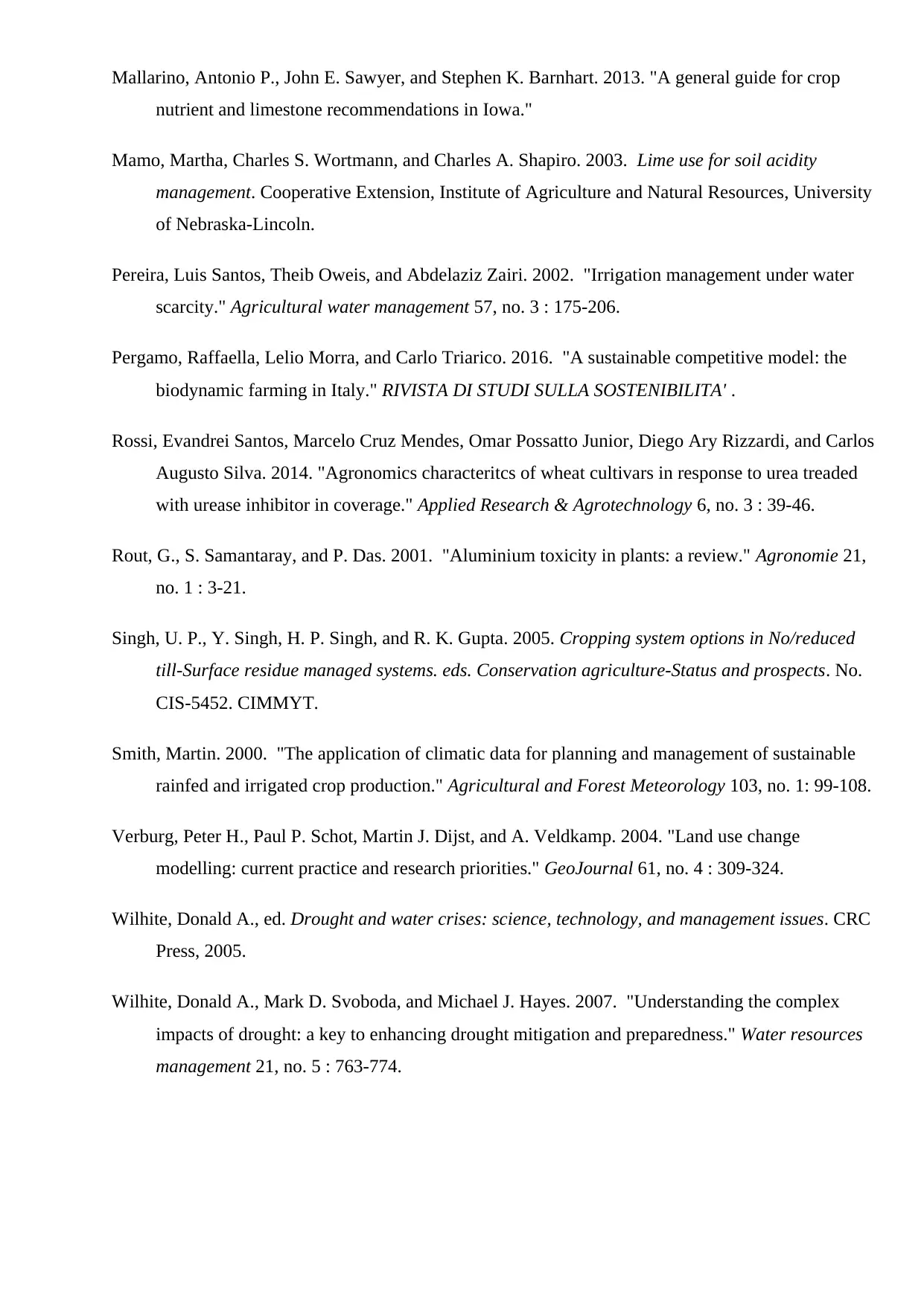
Mallarino, Antonio P., John E. Sawyer, and Stephen K. Barnhart. 2013. "A general guide for crop
nutrient and limestone recommendations in Iowa."
Mamo, Martha, Charles S. Wortmann, and Charles A. Shapiro. 2003. Lime use for soil acidity
management. Cooperative Extension, Institute of Agriculture and Natural Resources, University
of Nebraska-Lincoln.
Pereira, Luis Santos, Theib Oweis, and Abdelaziz Zairi. 2002. "Irrigation management under water
scarcity." Agricultural water management 57, no. 3 : 175-206.
Pergamo, Raffaella, Lelio Morra, and Carlo Triarico. 2016. "A sustainable competitive model: the
biodynamic farming in Italy." RIVISTA DI STUDI SULLA SOSTENIBILITA' .
Rossi, Evandrei Santos, Marcelo Cruz Mendes, Omar Possatto Junior, Diego Ary Rizzardi, and Carlos
Augusto Silva. 2014. "Agronomics characteritcs of wheat cultivars in response to urea treaded
with urease inhibitor in coverage." Applied Research & Agrotechnology 6, no. 3 : 39-46.
Rout, G., S. Samantaray, and P. Das. 2001. "Aluminium toxicity in plants: a review." Agronomie 21,
no. 1 : 3-21.
Singh, U. P., Y. Singh, H. P. Singh, and R. K. Gupta. 2005. Cropping system options in No/reduced
till-Surface residue managed systems. eds. Conservation agriculture-Status and prospects. No.
CIS-5452. CIMMYT.
Smith, Martin. 2000. "The application of climatic data for planning and management of sustainable
rainfed and irrigated crop production." Agricultural and Forest Meteorology 103, no. 1: 99-108.
Verburg, Peter H., Paul P. Schot, Martin J. Dijst, and A. Veldkamp. 2004. "Land use change
modelling: current practice and research priorities." GeoJournal 61, no. 4 : 309-324.
Wilhite, Donald A., ed. Drought and water crises: science, technology, and management issues. CRC
Press, 2005.
Wilhite, Donald A., Mark D. Svoboda, and Michael J. Hayes. 2007. "Understanding the complex
impacts of drought: a key to enhancing drought mitigation and preparedness." Water resources
management 21, no. 5 : 763-774.
nutrient and limestone recommendations in Iowa."
Mamo, Martha, Charles S. Wortmann, and Charles A. Shapiro. 2003. Lime use for soil acidity
management. Cooperative Extension, Institute of Agriculture and Natural Resources, University
of Nebraska-Lincoln.
Pereira, Luis Santos, Theib Oweis, and Abdelaziz Zairi. 2002. "Irrigation management under water
scarcity." Agricultural water management 57, no. 3 : 175-206.
Pergamo, Raffaella, Lelio Morra, and Carlo Triarico. 2016. "A sustainable competitive model: the
biodynamic farming in Italy." RIVISTA DI STUDI SULLA SOSTENIBILITA' .
Rossi, Evandrei Santos, Marcelo Cruz Mendes, Omar Possatto Junior, Diego Ary Rizzardi, and Carlos
Augusto Silva. 2014. "Agronomics characteritcs of wheat cultivars in response to urea treaded
with urease inhibitor in coverage." Applied Research & Agrotechnology 6, no. 3 : 39-46.
Rout, G., S. Samantaray, and P. Das. 2001. "Aluminium toxicity in plants: a review." Agronomie 21,
no. 1 : 3-21.
Singh, U. P., Y. Singh, H. P. Singh, and R. K. Gupta. 2005. Cropping system options in No/reduced
till-Surface residue managed systems. eds. Conservation agriculture-Status and prospects. No.
CIS-5452. CIMMYT.
Smith, Martin. 2000. "The application of climatic data for planning and management of sustainable
rainfed and irrigated crop production." Agricultural and Forest Meteorology 103, no. 1: 99-108.
Verburg, Peter H., Paul P. Schot, Martin J. Dijst, and A. Veldkamp. 2004. "Land use change
modelling: current practice and research priorities." GeoJournal 61, no. 4 : 309-324.
Wilhite, Donald A., ed. Drought and water crises: science, technology, and management issues. CRC
Press, 2005.
Wilhite, Donald A., Mark D. Svoboda, and Michael J. Hayes. 2007. "Understanding the complex
impacts of drought: a key to enhancing drought mitigation and preparedness." Water resources
management 21, no. 5 : 763-774.
1 out of 5
Related Documents
Your All-in-One AI-Powered Toolkit for Academic Success.
+13062052269
info@desklib.com
Available 24*7 on WhatsApp / Email
![[object Object]](/_next/static/media/star-bottom.7253800d.svg)
Unlock your academic potential
© 2024 | Zucol Services PVT LTD | All rights reserved.





